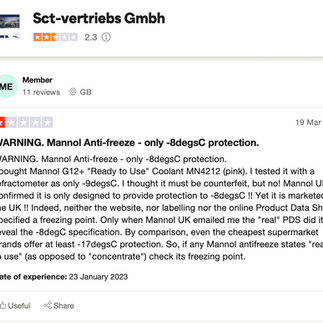
Coolant Catastrophe? Mannol 4212 G12+ and Its Not-So-Freezing Freeze Point
Jul 30, 2024
2 min read
It's quite the discovery that Mannol 4212 G12+ ready-to-use antifreeze doesn't specify its freeze point on the TDS, SDS, or even the container. A deep dive into Section 9 of their SDS reveals the product contains 78-80% water. Should the remaining value be 20-22% monoethylene glycol, the product will only provide freeze protection to -8°C.This will not provide adequate freeze protection for some regions of the UK and will only offer borderline protection in certain areas, leaving most of the UK running the risk of engine block failures due to freezing and expanding water in those delicate coolant galleries. Who doesn't love a little suspense?
Glycol serves a dual purpose: it provides freeze protection and raises the boiling temperature of the coolant. In a standard 50% antifreeze/coolant and 50% water mixture, the boiling point is elevated to approximately 108-109°C. However, when the mixture is adjusted to a 20% antifreeze and 80% water ratio, the boiling point decreases by 5°C. While this reduction might seem minor, it could still be significant enough to help prevent engine failure due to overheating. (https://sct-online.sct-germany.de/SCTApprovalControl/module/msdsImport/msds_upload_tmp/sdMN4212_-_MANNOL%204212%20Coolant%20G12+_(IE).pdf)
Furthermore, at a lower dilution ratio, the reserve alkalinity of the antifreeze is diminished. This refers to the antifreeze's capacity to maintain a stable pH range when exposed to acidic compounds. If the antifreeze becomes contaminated with acids, this buffering ability helps delay the drop to a low pH level, which would otherwise accelerate corrosion and degrade the glycol.
Mannol 4212 G12+ claims “up to 6 years” (in stationary engines) and a “service life: no less than 5 years.” However, given the water content specified in the SDS, it may not offer adequate corrosion protection. According to their technical data sheets, many reputable manufacturers typically recommend a minimum dilution of 33% antifreeze to water to ensure sufficient corrosion protection.

The product’s extensive list of specifications includes recommendations for a 50% antifreeze to 50% water dilution ratio. As noted in their own guidelines, "Comply with the manufacturer’s instructions provided in the user’s manual." Given this, it appears that the product may not be suitable for its intended purpose.
Interestingly, some customers have shared their experiences on Trustpilot and noticed these nuances. Clearly, this product sets a new standard in antifreeze expectations.













